Drugs
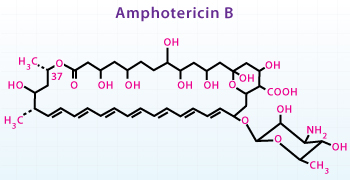 Treating for life–threatening fungal infections
This medication should only be used for the treatment of
potentially life–threatening fungal infections and not to treat less serious fungal infections
of the mouth, throat, or vagina in patients with a normal immune system (body's natural protection
against infection).
Treating for life–threatening fungal infections
This medication should only be used for the treatment of
potentially life–threatening fungal infections and not to treat less serious fungal infections
of the mouth, throat, or vagina in patients with a normal immune system (body's natural protection
against infection).
Amphotericin (B)
It is an antibiotic of complex structure which is insoluble in water and unstable at 37°C.
Mechanism of action:
- Like other polyene antibiotics (e.g.nystatin), amphotericin binds to cell membranes and interferes with permeability and with transport functions.
- It forms a pore in the membrane, creating a transmembrane ion–channel.
- This results in a loss of intracellular K+ ions.
Specificity of its action:
- It has a selective action, binding avidly to the membranes of fungi and some protozoa, less avidly than mammalian cells and not at all to bacteria.
- This specificity is due to the drug's greater affinity for ergosterol (the fungal membrane sterol) than for cholesterol.
- It is active against most fungi and yeasts.
- Amphotericin enhances the antifungal activity of rifampicin, which does not otherwise have antifungal properties.
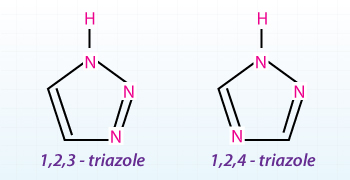 Triazole rings
It is a five–membered heterocyclic ring containing two
carbon and three nitrogen atoms. These are anti–fungal in nature.
Triazole rings
It is a five–membered heterocyclic ring containing two
carbon and three nitrogen atoms. These are anti–fungal in nature.
Azoles
They are a group of synthetic antimycotic agents with a broad–spectrum of activity.
The main drugs available are:
Ketoconazole, Fluconazole,
Itraconazole, Voriconazole,
Clotrimazole, Econazole,
Miconazole, Tioconazole,
Sulconazole, Butaconazole,
Oxiconazole, Terconazole.
Mechanism of the action of azoles:
- The azoles block the synthesis of ergosterol, the main sterol fungal cell membranes, by interacting with the enzyme necessary for the conversion of lanosterol to ergosterol.
- The overall effect is an inhibition of the transformation of candidal yeast cells into hyphe–the invasive and pathogenic form of the parasite.
Ketoconazole
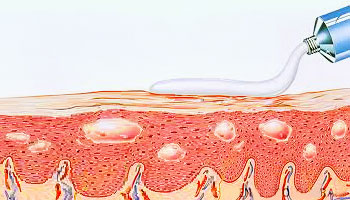 Topical application
Azole antifungal's are a group of fungistatic agents with
broad–spectrum activity.
Topical application
Azole antifungal's are a group of fungistatic agents with
broad–spectrum activity.
- Ketoconazole was the first azole that could be given orally to treat systematic fungal infections.
- It is effective against several different types of fungi.
- However, it is toxic and relapse is common after apparently successful treatment.
Topical azoles:
Some of the topical azoles are Clotrimazole, Miconazole, Econazole, Tioconazole, Sulconazole,
Butaconazole, Oxiconazole, Terconazole.
- They are azole antifungal agents used for topical application.
- Clotrimazole interferes with amino acid transport into the organism by an action of cell membrane.
- Clotrimazole can also be given orally especially in the treatment of oropharyngeal candidiasis.
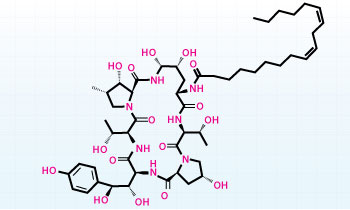 Echinocandin B
Echinocandin B is a lipopeptide with antifungal activity.I.
Echinocandin B
Echinocandin B is a lipopeptide with antifungal activity.I.
Echinocandins
Echinocandins are the newest class of antifungal agent to be developed.
They are large cyclic peptides linked to a long–chain fatty acid.
Caspofungin, micafungin and anidulafungin are the only licensed agents in this category of antifungals,
although other drugs are under active
investigation. These agents are active against both candida and aspergillus, but not Cryptococcus
neoformans.
Mechanism of action:
Echinocandins act at the level of the fungal cell wall by inhibiting the synthesis of β(1 –
3) D – glucan.
This results in disruption of the fungal cell wall and cell death.
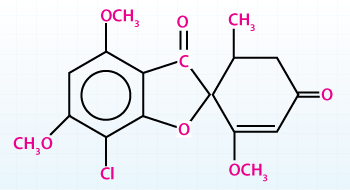 Griseofulvin
Griseofulvin is used to treat skin infections such as jock itch, athlete's foot, and ringworm; and fungal infections of the scalp, fingernails, and
toenails.
Griseofulvin
Griseofulvin is used to treat skin infections such as jock itch, athlete's foot, and ringworm; and fungal infections of the scalp, fingernails, and
toenails.
Griseofulvin
- It is a narrow–spectrum antifungal isolated from penicillin grisefulvum.
- It is fungistatic and its mechanism of action involves an interaction with spindle formation in dividing cells and therefore with mitosis.
- Impairment of microtubule function also interferes with the transport of material through the cytoplasm to the periphery, and this action is the basis of the inhibition of hyphal cell wall synthesis.
- In addition the drug binds to RNA inhibiting nucleic acid synthesis.
- Resistance has not been a clinical problem yet.